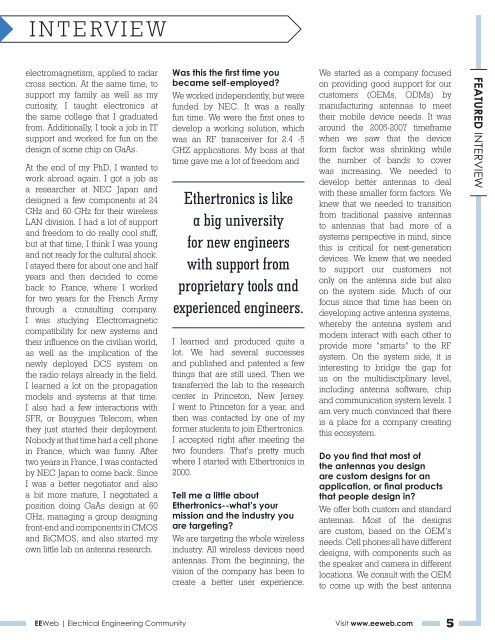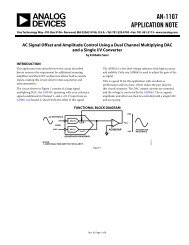Interview with Laurent Desclos - EEWeb
Interview with Laurent Desclos - EEWeb
Interview with Laurent Desclos - EEWeb
You also want an ePaper? Increase the reach of your titles
YUMPU automatically turns print PDFs into web optimized ePapers that Google loves.
INTERVIEW<br />
electromagnetism, applied to radar<br />
cross section. At the same time, to<br />
support my family as well as my<br />
curiosity, I taught electronics at<br />
the same college that I graduated<br />
from. Additionally, I took a job in IT<br />
support and worked for fun on the<br />
design of some chip on GaAs.<br />
At the end of my PhD, I wanted to<br />
work abroad again. I got a job as<br />
a researcher at NEC Japan and<br />
designed a few components at 24<br />
GHz and 60 GHz for their wireless<br />
LAN division. I had a lot of support<br />
and freedom to do really cool stuff,<br />
but at that time, I think I was young<br />
and not ready for the cultural shock.<br />
I stayed there for about one and half<br />
years and then decided to come<br />
back to France, where I worked<br />
for two years for the French Army<br />
through a consulting company.<br />
I was studying Electromagnetic<br />
compatibility for new systems and<br />
their influence on the civilian world,<br />
as well as the implication of the<br />
newly deployed DCS system on<br />
the radio relays already in the field.<br />
I learned a lot on the propagation<br />
models and systems at that time.<br />
I also had a few interactions <strong>with</strong><br />
SFR, or Bouygues Telecom, when<br />
they just started their deployment.<br />
Nobody at that time had a cell phone<br />
in France, which was funny. After<br />
two years in France, I was contacted<br />
by NEC Japan to come back. Since<br />
I was a better negotiator and also<br />
a bit more mature, I negotiated a<br />
position doing GaAs design at 60<br />
GHz, managing a group designing<br />
front-end and components in CMOS<br />
and BiCMOS, and also started my<br />
own little lab on antenna research.<br />
Was this the first time you<br />
became self-employed?<br />
We worked independently, but were<br />
funded by NEC. It was a really<br />
fun time. We were the first ones to<br />
develop a working solution, which<br />
was an RF transceiver for 2.4 -5<br />
GHZ applications. My boss at that<br />
time gave me a lot of freedom and<br />
Ethertronics is like<br />
a big university<br />
for new engineers<br />
<strong>with</strong> support from<br />
proprietary tools and<br />
experienced engineers.<br />
I learned and produced quite a<br />
lot. We had several successes<br />
and published and patented a few<br />
things that are still used. Then we<br />
transferred the lab to the research<br />
center in Princeton, New Jersey.<br />
I went to Princeton for a year, and<br />
then was contacted by one of my<br />
former students to join Ethertronics.<br />
I accepted right after meeting the<br />
two founders. That’s pretty much<br />
where I started <strong>with</strong> Ethertronics in<br />
2000.<br />
Tell me a little about<br />
Ethertronics--what’s your<br />
mission and the industry you<br />
are targeting?<br />
We are targeting the whole wireless<br />
industry. All wireless devices need<br />
antennas. From the beginning, the<br />
vision of the company has been to<br />
create a better user experience.<br />
We started as a company focused<br />
on providing good support for our<br />
customers (OEMs, ODMs) by<br />
manufacturing antennas to meet<br />
their mobile device needs. It was<br />
around the 2005-2007 timeframe<br />
when we saw that the device<br />
form factor was shrinking while<br />
the number of bands to cover<br />
was increasing. We needed to<br />
develop better antennas to deal<br />
<strong>with</strong> these smaller form factors. We<br />
knew that we needed to transition<br />
from traditional passive antennas<br />
to antennas that had more of a<br />
systems perspective in mind, since<br />
this is critical for next-generation<br />
devices. We knew that we needed<br />
to support our customers not<br />
only on the antenna side but also<br />
on the system side. Much of our<br />
focus since that time has been on<br />
developing active antenna systems,<br />
whereby the antenna system and<br />
modem interact <strong>with</strong> each other to<br />
provide more “smarts” to the RF<br />
system. On the system side, it is<br />
interesting to bridge the gap for<br />
us on the multidisciplinary level,<br />
including antenna software, chip<br />
and communication system levels. I<br />
am very much convinced that there<br />
is a place for a company creating<br />
this ecosystem.<br />
Do you find that most of<br />
the antennas you design<br />
are custom designs for an<br />
application, or final products<br />
that people design in?<br />
We offer both custom and standard<br />
antennas. Most of the designs<br />
are custom, based on the OEM’s<br />
needs. Cell phones all have different<br />
designs, <strong>with</strong> components such as<br />
the speaker and camera in different<br />
locations. We consult <strong>with</strong> the OEM<br />
to come up <strong>with</strong> the best antenna<br />
<strong>EEWeb</strong> | Electrical Engineering Community Visit www.eeweb.com 5<br />
FEATURED INTERVIEW















